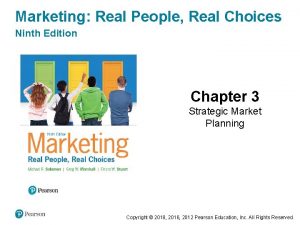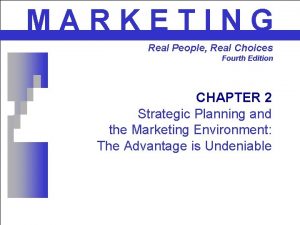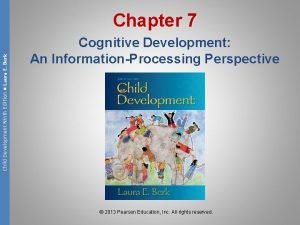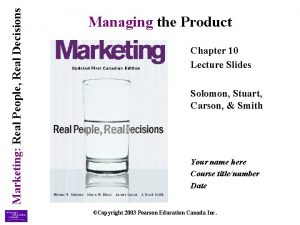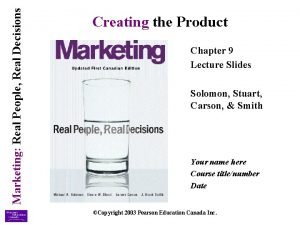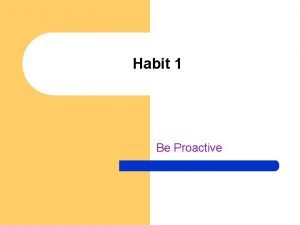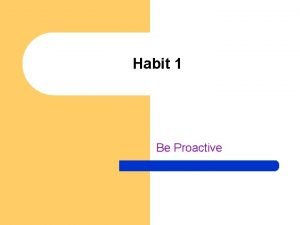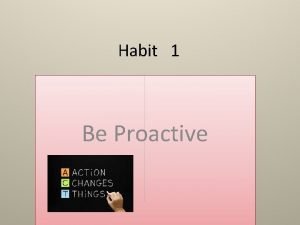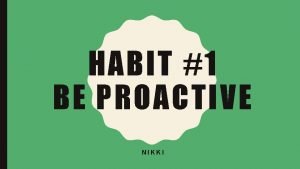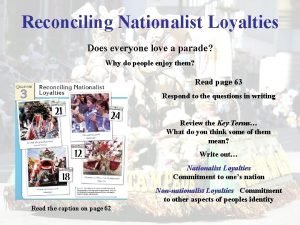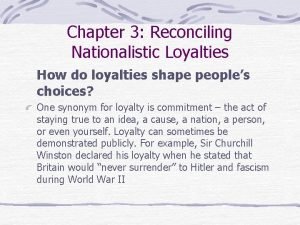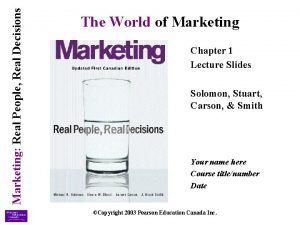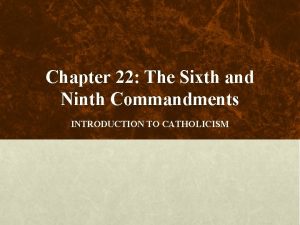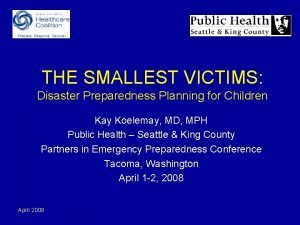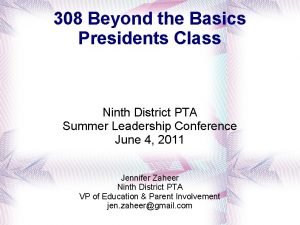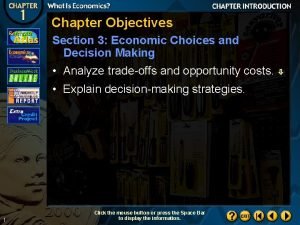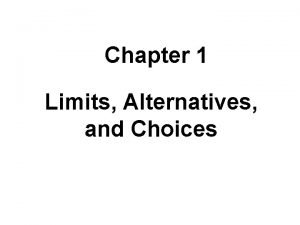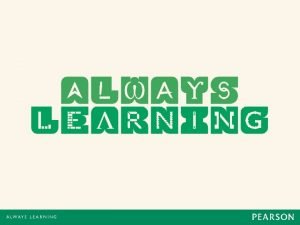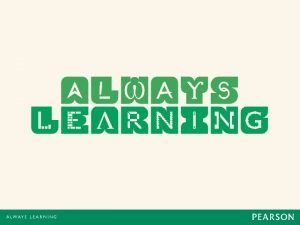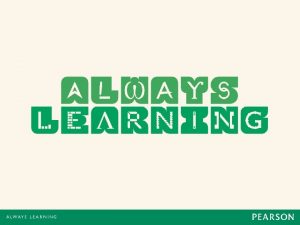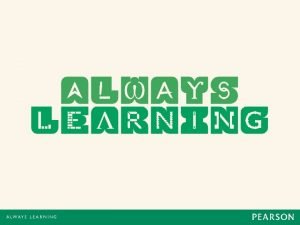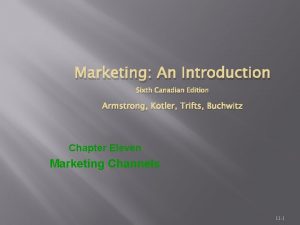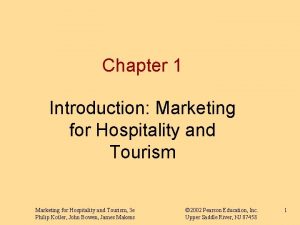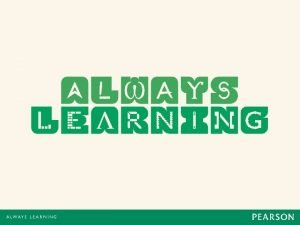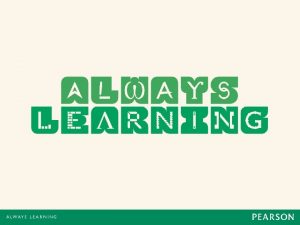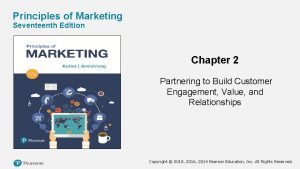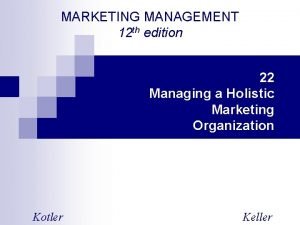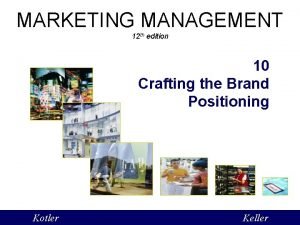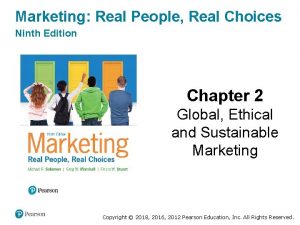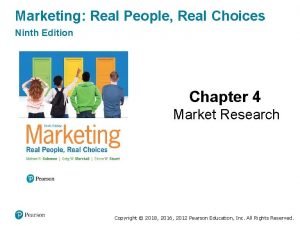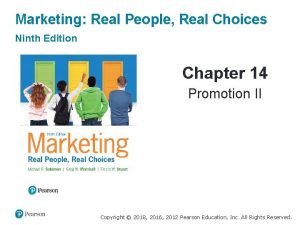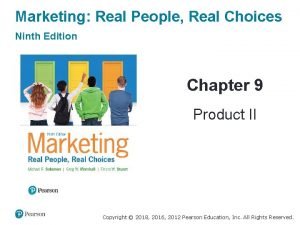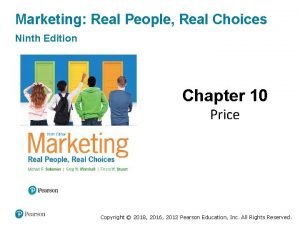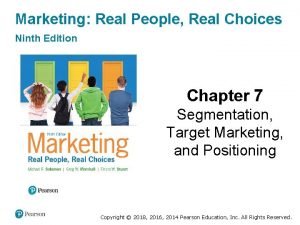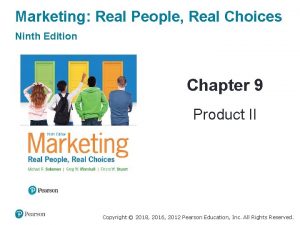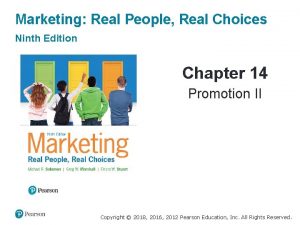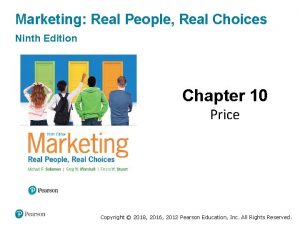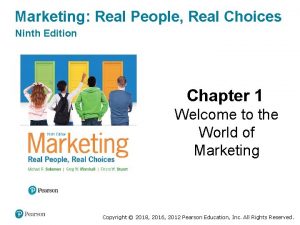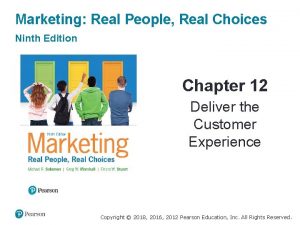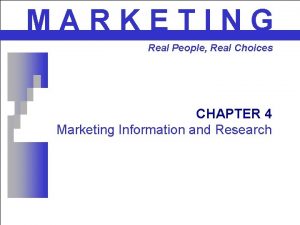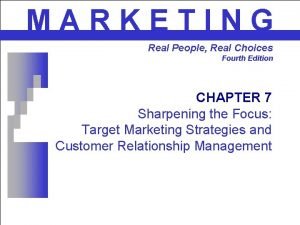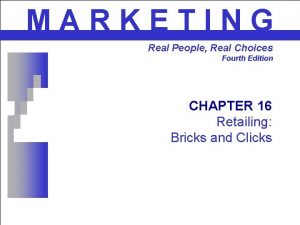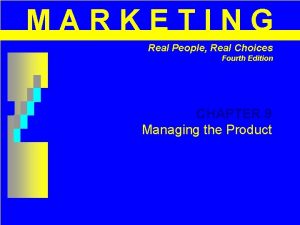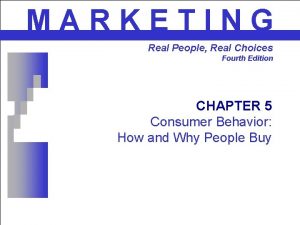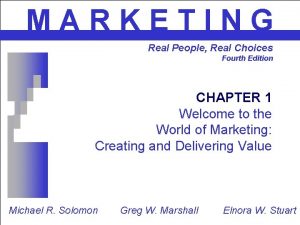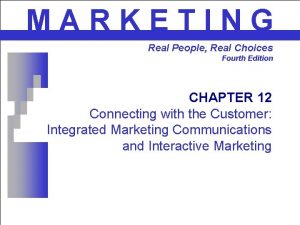Marketing Real People Real Choices Ninth Edition Chapter






















































- Slides: 54

Marketing: Real People, Real Choices Ninth Edition Chapter 12 Deliver the Customer Experience Copyright © 2018, 2016, 2012 Pearson Education, Inc. All Rights Reserved.

Learning Objectives 12. 1 Define retailing, understand how retailing evolves and consider some ethical issues in retailing. 12. 2 Understand how we classify traditional retailers. 12. 3 Describe business-to-consumer (B 2 C) ecommerce and the other common forms of non-store retailing. 12. 4 Understand the marketing of services and other intangibles. Copyright © 2018, 2016, 2012 Pearson Education, Inc. All Rights Reserved.

Real People, Real Choices: Eskimo Joe’s • Which option should Stan pursue? § Option 1: Convert the beer bar into a full-service restaurant that focuses on selling great food. § Option 2: Continue operating as a beer bar at the core and work to offset declining beer sales with an increase in apparel sales. § Option 3: Close Eskimo Joe’s bar and refocus resources on building the growing apparel business. Copyright © 2018, 2016, 2012 Pearson Education, Inc. All Rights Reserved.

Retailing, Twenty-First-Century Style • Retailing is the process by which organizations sell goods and services to consumers for their personal use. § Provide time, place, and ownership utility • Retailing is big business: § 2015 U. S. sales totaled $4. 87 trillion § More than 1 in 10 U. S. workers employed in retail § Retailing practices vary around the world. Copyright © 2018, 2016, 2012 Pearson Education, Inc. All Rights Reserved.

The Evolution of Retailing • Retailing has taken many forms over time – § From the peddler hawking wares from a horse-drawn cart to a majestic urban department store • As the economic, social, and cultural climates change, different retail types emerge … § Often squeezing out older, outdated models § Wheel-of-retailing hypothesis Copyright © 2018, 2016, 2012 Pearson Education, Inc. All Rights Reserved.

Figure 12. 1 The Wheel of Retailing Copyright © 2018, 2016, 2012 Pearson Education, Inc. All Rights Reserved.

The Evolution Continues: What’s “In -Store” for the Future? • Four factors motivate innovative merchants to reinvent the way they do business: § § Changes in economic conditions Demographic and consumer preference change Technology Globalization Copyright © 2018, 2016, 2012 Pearson Education, Inc. All Rights Reserved.

The Changing Economy • Economic downturn that began in 2008 had great impact on retailers § Lowered consumer confidence resulted in less discretionary spending. • Sales for upscale stores especially vulnerable § Stores like T. J. Maxx, Marshall’s, and Amazon. com thrived. § Some retailers responded by allocating more shelf space to private label brands. Copyright © 2018, 2016, 2012 Pearson Education, Inc. All Rights Reserved.

Changing Demographics and Consumer Preferences (1 of 2) • More dual-career families places greater emphasis on convenience § Increased number of locations and format § Extended hours • Ethnic diversity § Need to adjust retail mix to attract consumers in areas with high concentration of ethnic population Copyright © 2018, 2016, 2012 Pearson Education, Inc. All Rights Reserved.

Changing Demographics and Consumer Preferences (2 of 2) Experiential Merchandising • Tactic whose intent is to convert shopping from a passive activity into a more interactive one, by better engaging the customer Destination Retailer • Firm that consumers view as distinctive enough to become loyal to it. Copyright © 2018, 2016, 2012 Pearson Education, Inc. All Rights Reserved.

Technology (1 of 2) • Technology is revolutionizing retailing! § Store associates carry an i. Pod Touch to quickly ring up sales from anywhere in the store § Electronic POS systems feed data into inventory control and auto replenishment systems § RFID tags on items § E-menus and other electronic ordering systems § Electronic banking Copyright © 2018, 2016, 2012 Pearson Education, Inc. All Rights Reserved.

Technology (2 of 2) • Omni-channel Marketing § Seamless shopping experience whether shopping online, mobile device, phone, or brick-and-mortar • Beacon Marketing § Bluetooth signal within a store that communicates with shoppers’ smartphones • Digital Wallets § Bluetooth technology permitting customers to use their smartphones to pay for items Copyright © 2018, 2016, 2012 Pearson Education, Inc. All Rights Reserved.

Globalization • Many retailers have expanded operations into different countries. § Retailers must adjust to global differences in culture, law, and regulations. Copyright © 2018, 2016, 2012 Pearson Education, Inc. All Rights Reserved.

Retailtainment to Satisfy Experiential Shoppers • Retailtainment is all about marketing strategies that enhance the shopping experience. § Many consumers are seeking fun! § Retail experiences that incorporate elements of surprise, excitement, and novelty lead to increased purchase likelihood. Copyright © 2018, 2016, 2012 Pearson Education, Inc. All Rights Reserved.

Ethical Problems in Retailing • Retailers must deal with ethical problems that involve both customers and employees. § § § Shoplifting Employee theft Retail “borrowing” Ethical treatment of customers Customer profiling Sale of harmful products Copyright © 2018, 2016, 2012 Pearson Education, Inc. All Rights Reserved.

Ethical/Sustainable Decisions in the Real World • Most clothing purchased in the United States is made in developing countries. • Workers earn less than a living wage. • Fair Trade movement is gaining momentum. Should all retailers seek out and buy Fair Trade goods? Copyright © 2018, 2016, 2012 Pearson Education, Inc. All Rights Reserved.

Retailing is Big Business – All Around the World! • Retail formats and practices are constantly evolving due to economic, social and cultural changes. § Wheel-of-retailing hypothesis explains retail change. • Many Western consumers are today seeking out entertainment in their retail experiences. Copyright © 2018, 2016, 2012 Pearson Education, Inc. All Rights Reserved.

Classify Retailers by What They Sell • One of the most important strategic decisions a retailer makes is what to sell—its merchandise mix. § Merchandise breadth: Number of different product lines § Narrow vs. broad assortment § Merchandise depth: Variety of choices available within each product line § Shallow vs. deep assortment Copyright © 2018, 2016, 2012 Pearson Education, Inc. All Rights Reserved.

Figure 12. 2 Classification of Book Retailers by Merchandise Selection Copyright © 2018, 2016, 2012 Pearson Education, Inc. All Rights Reserved.

Classify Retailers by Level of Service • Firms recognize trade-off between service and low prices and tailor strategies accordingly. • Retailers differ along a continuum based on amount of service provided to customers. § § § Self-service retailers (e. g, Sam’s Club) Full-service retailers (e. g, Bloomingdales) Limited-service retailers (e. g. , Walmart, Target, Kohl’s) Copyright © 2018, 2016, 2012 Pearson Education, Inc. All Rights Reserved.

Table 12. 1 Different Retailers Offer Varying Product Assortments, Levels of Service, Store Sizes, and Prices (1 of 3) Type Examples Convenience stores 7 -Eleven Supermarkets Publix, Kroger Box stores ALDI Specialty stores Yankee Candle Co. , Things Remembered Copyright © 2018, 2016, 2012 Pearson Education, Inc. All Rights Reserved.

Category Killer • A category killer is a specialty store that carries a large section of products within a given category. § Best Buy § Lowe’s § Toys-R-Us Copyright © 2018, 2016, 2012 Pearson Education, Inc. All Rights Reserved.

Table 12. 1 Different Retailers Offer Varying Product Assortments, Levels of Service, Store Sizes, and Prices (2 of 3) Type Examples Category killers Toys “R” Us, Home Depot, Best Buy Leased departments Picture Me portrait studios in Walmart stores Variety stores Dollar General, Dollar Tree General merchandise discount stores Walmart, Kmart Off-price retailers T. J. Maxx, Marshall’s Copyright © 2018, 2016, 2012 Pearson Education, Inc. All Rights Reserved.

Department Stores • Department stores sell a broad range of items and offer a deep selection organized into different sections. § Full-service U. S. department stores have struggled in recent years. Copyright © 2018, 2016, 2012 Pearson Education, Inc. All Rights Reserved.

Table 12. 1 Different Retailers Offer Varying Product Assortments, Levels of Service, Store Sizes, and Prices (3 of 3) Type Examples Warehouse clubs Costco, Sam’s Club, BJ’s Factory outlet stores Gap Outlet, Liz Claiborne Outlet, Coach Outlet Department stores Macy’s, Bloomingdale’s, Nordstrom Hypermarkets Carrefour Pop-up stores Halloween Costume pop-ups Copyright © 2018, 2016, 2012 Pearson Education, Inc. All Rights Reserved.

Popup Stores • Popup stores are temporary retail spaces that a company erects to help build buzz for its products. • Seasonal popup stores at Halloween and Christmas sell costumes and Christmas decorations. Copyright © 2018, 2016, 2012 Pearson Education, Inc. All Rights Reserved.

Types of Retail Stores • Retailers may be categorized based on a variety of factors, including: § Merchandise mix—both breadth and depth of assortment § Service levels offered to customers § Store size At how many different retailer types can a consumer purchase a gallon milk? A greeting card? Gasoline? Copyright © 2018, 2016, 2012 Pearson Education, Inc. All Rights Reserved.

E-Commerce and Other Types of Nonstore Retailing • Nonstore retailing is any method a firm uses to complete an exchange that does not require a customer to visit a store Copyright © 2018, 2016, 2012 Pearson Education, Inc. All Rights Reserved.

B 2 C E-Commerce B 2 C e-commerce is online exchange between companies and individual consumers. § Shoppers purchased $373 billion in consumer goods online in 2016. • Experts predict that by 2017: § 60% of all U. S. retail sales will involve the web in some way. § Web-influenced sales will increase to $1. 8 trillion. M-commerce is promotional or other e-commerce activities over mobile devices. Copyright © 2018, 2016, 2012 Pearson Education, Inc. All Rights Reserved.

Table 12. 2 Benefits and Limitations of E-Commerce (1 of 4) Benefits For the Consumer Shop 24 hours a day Less traveling Can receive relevant information in seconds from any location More product choices More products available to less developed countries Greater price information Lower prices, so less affluent can purchase Participate in virtual auctions Fast delivery Electronic communities Copyright © 2018, 2016, 2012 Pearson Education, Inc. All Rights Reserved.

Table 12. 2 Benefits and Limitations of E-Commerce (2 of 4) Benefits For the Marketer The world is your marketplace Decreases costs of doing business Very specialized businesses can succeed Real-time pricing Copyright © 2018, 2016, 2012 Pearson Education, Inc. All Rights Reserved.

Benefits of B 2 C E-Commerce Virtual Experiential Marketing is an online marketing strategy that engages experiential shoppers online by using: • Colors • Graphics • Layout and Design • Interactive Videos • Contests • Games • Giveaways Copyright © 2018, 2016, 2012 Pearson Education, Inc. All Rights Reserved.

Table 12. 2 Benefits and Limitations of E-Commerce (3 of 4) Limitations For the Consumer Lack of security Fraud Can’t touch items Exact colors may not reproduce on computer monitors Expensive to order and then return Potential breakdown of human relationships Copyright © 2018, 2016, 2012 Pearson Education, Inc. All Rights Reserved.

Table 12. 2 Benefits and Limitations of E-Commerce (4 of 4) Limitations For the Marketer Lack of security Must maintain site to reap benefits Fierce price competition due to total transparency for branded products Conflicts with conventional retailers Legal issues not resolved Copyright © 2018, 2016, 2012 Pearson Education, Inc. All Rights Reserved.

Limitations of B 2 C E-Commerce Shopping Cart Abandonment occurs when ecommerce customers leave an e-commerce site with unpurchased items in their cart. Copyright © 2018, 2016, 2012 Pearson Education, Inc. All Rights Reserved.

B 2 C’s Effect on the Future of Retailing • Does growth of B 2 C e-commerce mean the death of bricks-and-mortar stores as we know them? § Virtual distribution channels unlikely to replace traditional ones • Stores must evolve to lure customers away from the computer. § Consumers will visit destination retail more for the fun they receive from the total experience. Copyright © 2018, 2016, 2012 Pearson Education, Inc. All Rights Reserved.

Direct Selling • Direct selling occurs when a salesperson presents a product to one individual or a small group, takes orders, and delivers the merchandise. § Door-to-door sales § Party and networks § Multilevel marketing Copyright © 2018, 2016, 2012 Pearson Education, Inc. All Rights Reserved.

Automatic Vending • Automatic vending § Usually best suited to low-cost convenience goods § Offers many benefits to consumers and marketers Copyright © 2018, 2016, 2012 Pearson Education, Inc. All Rights Reserved.

Nonstore Retailing • Nonstore retailing encompasses: § B 2 C e-commerce § Direct selling § Automatic vending • Many conventional retailers—from Tiffany’s to Walmart—offer nonstore alternatives. Is multilevel marketing the same as a pyramid scheme? Copyright © 2018, 2016, 2012 Pearson Education, Inc. All Rights Reserved.

Marketing What isn’t There • Services are acts, efforts, or performances exchanged from producer to user without ownership rights. § Service industry account for four out of every five jobs in the United States and nearly 80% of GDP. § Services are targeted toward both consumers and organizations. § Intangibility of services creates unique opportunities and challenges for marketing. Copyright © 2018, 2016, 2012 Pearson Education, Inc. All Rights Reserved.

Figure 12. 4 Characteristics of Services Copyright © 2018, 2016, 2012 Pearson Education, Inc. All Rights Reserved.

Characteristics of Services (1 of 2) • Intangibility § Can’t see, touch, or smell good service § Marketers provide physical cues • Perishability § Impossible to store for later sale or consumption § Capacity management Copyright © 2018, 2016, 2012 Pearson Education, Inc. All Rights Reserved.

Characteristics of Services (2 of 2) • Variability § Service can vary § Difficult to standardize services • Inseparability § Impossible to separate the production and consumption of a service § Disintermediation Copyright © 2018, 2016, 2012 Pearson Education, Inc. All Rights Reserved.

The Service Encounter • A service encounter occurs when the customer comes into contact with the organization. § Social contact dimension § Physical dimension • Quality of the service encounter exerts a big impact on service quality evaluations. § Customer also plays a role in service experiences. Copyright © 2018, 2016, 2012 Pearson Education, Inc. All Rights Reserved.

Physical Elements of the Service Encounter • Servicescapes are the actual physical facility where the service is performed, delivered, and consumed. § Includes exterior and interior elements of the service facility § Servicescapes can influence customer perceptions. § Not as important if customer does not have to visit a designated location Copyright © 2018, 2016, 2012 Pearson Education, Inc. All Rights Reserved.

How We Provide Quality Service • Quality service ensures that customers are satisfied with what they have paid for. • Satisfaction is based on customer expectations. § Not all customers expect the same level of service. § Not all customers can be satisfied. Copyright © 2018, 2016, 2012 Pearson Education, Inc. All Rights Reserved.

Strategic Issues When We Deliver Service Quality • The SERVQUAL scale is a popular instrument to measure customer service quality. • SERVQUAL identifies consumer perceptions of service quality on five components: § § § Tangibles Reliability Responsiveness Empathy Assurance Copyright © 2018, 2016, 2012 Pearson Education, Inc. All Rights Reserved.

Marketing People, Places, and Ideas • Services are not the only intangibles that organizations need to market. § Intangibles such as people, places, and ideas must also be marketed. Copyright © 2018, 2016, 2012 Pearson Education, Inc. All Rights Reserved.

Marketing People • Politicians, athletes, and celebrities are commonly marketed. § Consultants “package” celebrities § Name changes and rebranding are common Copyright © 2018, 2016, 2012 Pearson Education, Inc. All Rights Reserved.

Table 12. 4 Strategies to Sell a Celebrity Marketing Approach Pure selling approach Blank Blank Implementation Agent presents a client to the following: Record companies Movie studios TV production companies Talk show hosts Advertising agencies Talent scouts Product improvement approach Client is modified: Blank Blank Market Fulfillment approach Blank New name New image Voice lessons Dancing lessons Plastic surgery New backup band New music genre Agent looks for market opening: Blank Develop a new product (band or singer) to the specifications of consumer wants Identify unmet need Copyright © 2018, 2016, 2012 Pearson Education, Inc. All Rights Reserved.

Marketing Places • Place marketing strategies treat a city, state, country, or other locale as a brand. § Michigan Travel and Tourism Site Copyright © 2018, 2016, 2012 Pearson Education, Inc. All Rights Reserved.

Marketing Ideas • Idea marketing § Gaining market share for a concept, philosophy, belief, or issue (e. g. , religious institutions market ideas about faith) § Consumers often do not perceive the value they receive when they conform with an idea or fail to believe an idea is worth its ultimate cost. Copyright © 2018, 2016, 2012 Pearson Education, Inc. All Rights Reserved.

Figure 12. 5 Factors that Shape the Future of Services Copyright © 2018, 2016, 2012 Pearson Education, Inc. All Rights Reserved.

Copyright © 2018, 2016, 2012 Pearson Education, Inc. All Rights Reserved.
 Marketing real people real choices 11th edition
Marketing real people real choices 11th edition Ch 9 ream people real choice case study
Ch 9 ream people real choice case study Marketing real people real choices
Marketing real people real choices Levels of analysis psychology
Levels of analysis psychology Mankiw macroeconomics 9th edition
Mankiw macroeconomics 9th edition Human anatomy & physiology edition 9
Human anatomy & physiology edition 9 Psychology ninth edition david g myers
Psychology ninth edition david g myers Social psychology ninth edition
Social psychology ninth edition Biology ninth edition
Biology ninth edition Child development ninth edition
Child development ninth edition Berk 2013 child development
Berk 2013 child development Lysanx
Lysanx Psychology ninth edition in modules
Psychology ninth edition in modules Psychology ninth edition david g myers
Psychology ninth edition david g myers Biology ninth edition
Biology ninth edition Campbell ninth edition
Campbell ninth edition Marketing real people real decisions
Marketing real people real decisions Marketing real people real decisions
Marketing real people real decisions Proactive
Proactive Proactive vs reactive scenarios
Proactive vs reactive scenarios Proactive people make choices based on
Proactive people make choices based on Reactive language vs proactive language
Reactive language vs proactive language Reconciling contending loyalties
Reconciling contending loyalties How do nationalist loyalties shape people's choices
How do nationalist loyalties shape people's choices Marketing real people
Marketing real people The sixth commandment catholic
The sixth commandment catholic The sixth and ninth commandments
The sixth and ninth commandments Phos greek root words
Phos greek root words What is ranadan
What is ranadan William blount 9th grade academy
William blount 9th grade academy Lower ninth ward
Lower ninth ward Fifteenth course in french classical menu is
Fifteenth course in french classical menu is Ninth district pta
Ninth district pta Using mis (10th edition) 10th edition
Using mis (10th edition) 10th edition Chapter 1
Chapter 1 The health skill that involves taking the time
The health skill that involves taking the time Economics unit 1 lesson 2 difficult choices
Economics unit 1 lesson 2 difficult choices Chapter 9 making healthy food choices review answers
Chapter 9 making healthy food choices review answers How do job choices affect income
How do job choices affect income Chapter 1 section 3 economic choices and decision making
Chapter 1 section 3 economic choices and decision making Chapter 1 limits alternatives and choices
Chapter 1 limits alternatives and choices Marketing management (arab world edition)
Marketing management (arab world edition) Marketing management (arab world edition) philip kotler
Marketing management (arab world edition) philip kotler Marketing management (arab world edition) philip kotler
Marketing management (arab world edition) philip kotler Marketing management (arab world edition) philip kotler
Marketing management (arab world edition) philip kotler Marketing for hospitality and tourism 7th edition ppt
Marketing for hospitality and tourism 7th edition ppt Marketing an introduction 6th canadian edition
Marketing an introduction 6th canadian edition Marketing for hospitality and tourism 7th edition ppt
Marketing for hospitality and tourism 7th edition ppt Marketing management (arab world edition) philip kotler
Marketing management (arab world edition) philip kotler Marketing management (arab world edition)
Marketing management (arab world edition) Global marketing 9th edition
Global marketing 9th edition Principles of marketing fifth european edition
Principles of marketing fifth european edition Principles of marketing seventeenth edition
Principles of marketing seventeenth edition Marketing management 12th edition
Marketing management 12th edition Marketing management 12th edition
Marketing management 12th edition

